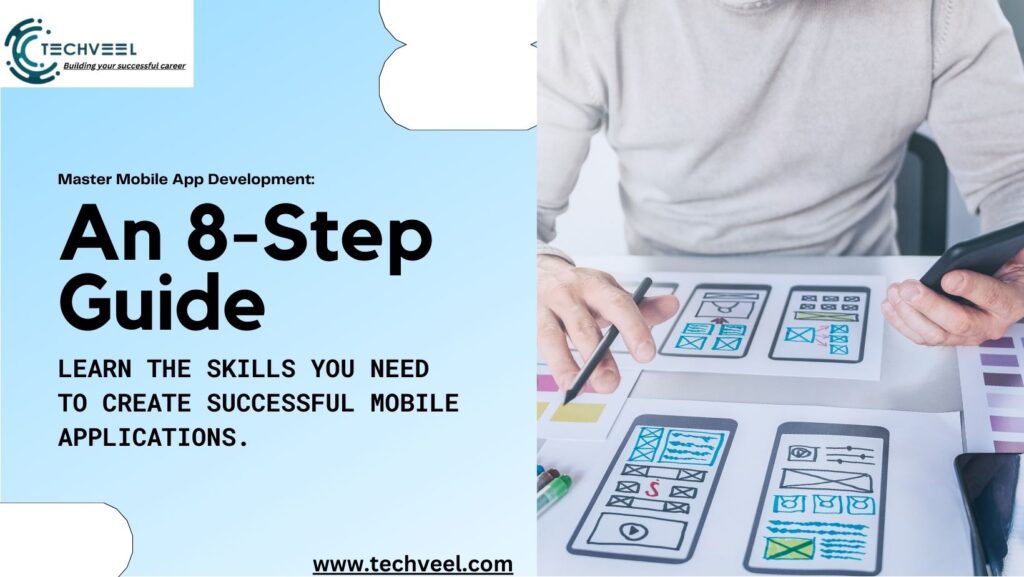An 8 Step Guide to Master in Mobile App Development.

Introduction:
Thanks to the variety of mobile applications that may meet every demand, mobile phones have become an essential part of our daily lives.Businesses are turning to mobile to improve consumer experiences, which is driving up demand for qualified app developers. We’ve broken down the whole process of developing a mobile app into eight achievable phases in this thorough guide to make sure your quest for a successful mobile app is a success.
Step 1: Determine the Purpose
Every excellent app begins with a specific goal in mind. Determine a need or an issue that your app can satisfy. Successful apps occasionally address issues that consumers weren’t even aware they had. Try “Splitwise,” an app that enables users to monitor spending, especially while dining out with friends. It makes life simpler by removing the need to record spending on paper.
Step 2: Identify the Competition
Having a first-mover advantage is uncommon in today’s technologically advanced society. Most likely, apps that are similar to your idea already exist. Do some research and make a list of these rivals. The key is differentiation. What makes your app unique? Is the change significant enough to provide users with true value? Think about your app’s target market, pricing, user experience, and methods to stand out from competitors.
Step 3: Choose the Operating System
Operating systems like iOS and Android are used to run mobile apps. You must choose between creating hybrid software that runs on several operating systems or a native app that is specific to a single OS. Your decision will be influenced by things like your target market, financial limitations, and particular needs.
Step 4: Define Functionality
Plan the functionality of your app at this time. Take into account navigation, interactive elements, colour palettes, themes, and user interface (UI) design. You will have a guide to follow if you sketch out these specifics.
Step 5: Develop a Plan
Choose a programming language, such as Java, JavaScript, Python, C, or C++, that you will use for coding. Select a development technique, such as Rapid Application Development (RAD), Prototype, Scrum, Agile, DevOps, Lean, or Extreme Programming (XP), that is appropriate for your project. Make a development schedule to help you and your team stay on schedule.
Step 6: Build a Prototype
A prototype is a preliminary version of your app. Share it with a select group, including reviewers, stakeholders, and managers, to gather feedback. This feedback is invaluable for making necessary improvements before launching your app to the wider audience.
Step 7: Testing
Testing is crucial to ensuring your app functions smoothly. Involve stakeholders like clients, employees, and potential users in testing. Collect their feedback and address any issues or concerns. Questions to ask testers include: What are the app’s best and worst features? Is the user interface user-friendly? Are there any operational issues? Does the app appeal to users visually?
Step 8: Launching
The final step involves launching your app in app stores like Google Play Store or Apple App Store. Ensure you thoroughly review the guidelines and requirements of the chosen platform. Successful marketing is also essential to make potential users aware of your app’s existence and its benefits.
Conclusion:
Mobile app development is a thriving field with limitless potential. However, success requires meticulous planning and execution. By following these 8 steps, you can navigate the complex journey of app development and bring your innovative ideas to life.
FAQs:
- Can apps be developed for both iOS and Android?
– Yes, most apps are designed to run on both operating systems to reach a wider audience.
- Will I own the source code after development?
– Ownership of the source code depends on your agreement with the developer or development team.
- Is knowing the app’s category important?
– Yes, categorizing your app helps users discover it more easily in app stores.
- What factors affect app development cost?
– Costs depend on various factors, including design complexity, development time, testing, coding, and integration.
- How often should I update my app?
– App updates should align with market trends and user demands, focusing on enhancing the user experience.
Embark on your mobile app development journey today, and turn your innovative ideas into reality with techveel 90 Days Internship Programme.
To Know more Contact Us | About Us
[wpforms id=”5855″ title=”false” description=”false”]
